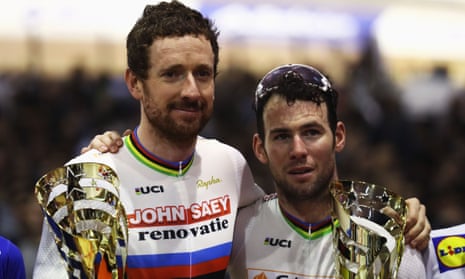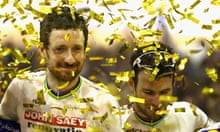A grim concrete building in Ghent’s citadel park with a strong aroma of fast food might have seemed a strange venue for a Tour de France winner to bid farewell – whether provisionally or not – but this place and this event have particular resonance for Sir Bradley Wiggins.
He was born in Ghent – hence his second name, the Flemish Marc – and not only did he win this race in 2003 as a young professional but he has strong memories of coming here to watch his late father Gary race in the 1980s. He had, he said last week, a photograph taken of the two in one of the claustrophobic cabins in the track centre where the riders rest between races and over the weekend there is every chance he took a similar snap with his children Bella and Ben.
“A lot of people don’t know about this building and what’s gone on here,” Wiggins said afterwards. “I first came here when I was a little boy; I spoke today with Maurice Burton” – a former six-day rider from south London – “and he remembered sitting in the riders’ cabins holding me in his arms. I always get emotional when I think about this place, what it means to me. I always think of my dad when I’m in here.
“He was a terrible father but I still idolise him as a bike rider because I wouldn’t be here without him. I can’t help but think about that.
“Me mum was here and people I haven’t seen for years; that’s more important than anything else. It’s such a special place, the dirt on the windows have probably been here since [the Belgian world champions] Rik van Looy and Van Steenbergen were riding here.”
The six is a throwback, a blend of circus and bike race, all loud music, fast food and flashing lights, one of the last survivors of an extensive circuit that once kept professionals busy through the European winter.
First held in 1922, it has recently become a magnet for British fans due to Ghent’s relative proximity to the Channel ports; the late Tom Simpson was a fixture in the 1960s – when his party trick was to ride wall of death style up the vertical advertising hoardings above the board – and Tony Doyle won the event in 1986 and 1991. This year a third of the tickets went to Britons.
The track is shorter than average at 165m, with steeper bankings than the norm – its nickname, ’t Kuipke, means ‘hipbath’ – but the obvious risks did not put the riders off spending the first 15 laps of a scratch race inciting the crowd to perform a Mexican wave by enacting one themselves on their bikes with their hands off the bars. There has long been debate about the extent to which the races may or may not be “arranged” but what cannot be denied is the consummate skill and nerve it takes to race the Madison, in particular, in such claustrophobic surroundings.
The standings are taken from a combination of laps lost and gained in the Madisons and points scored in other events such as the scratch, lap time trial and the “Derny” race, in which the riders are paced at speed by small motorbikes which add another, quite terrifying dimension to proceedings. It all meant that going into the final event Cavendish and Wiggins were lying third overall, with the local riders Kenny de Ketele and Moreno de Pauw leading from another local, Iljo Keisse, and his Italian partner, Elia Viviani.
During the closing 60-minute Madison, the three teams swapped the lead time after time but the final verdict went to the Britons, who managed to elude the other two pairs in the final 15 laps in much the same way that they won their world title in London in March.
The crucial lap gain was secured five out to ensure that, although it was Cavendish who was thrown in to cross the line with his arms in the air, Wiggins ended his career on an appropriate winning note – assuming, of course, that this is the end.
What sounded like his final winner’s press conference, whatever the ambiguities, ended with a question about how he would be remembered, answered with a ramble about being a bit anti-establishment but having accepted a knighthood, closing with the clincher, a sarcastic, “I’m not being contradictory. Whatever.” It was followed by one final expletive. If this is how the Wiggins era closes, it was all completely in character.






Comments (…)
Sign in or create your Guardian account to join the discussion